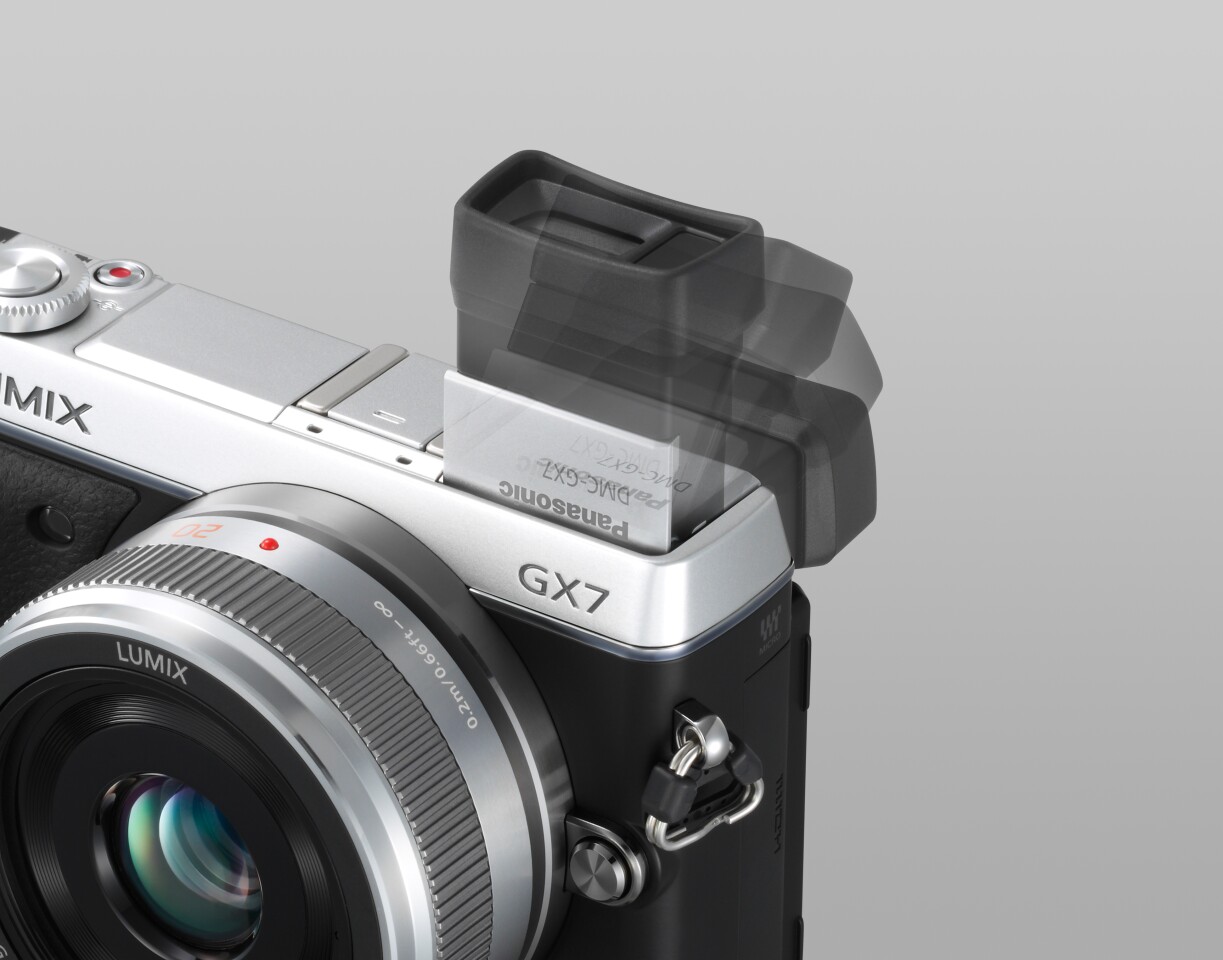Panasonic has revealed its latest retro-styled mirrorless interchangeable lens camera, the Lumix DMC-GX7. As well as making some detail and color saturation improvements to its newly-redesigned Live MOS sensor, the company has also treated the new addition to built-in Wi-Fi and NFC capabilities, in-body image stabilization, and a silent shooting mode. Stealing the show, however, are the Live Viewfinder and the rear display panel – both of which tilt.
The Lumix GX7 high end Digital Single Lens Mirrorless (DSLM) camera sports a camcorder-like tilting electronic viewfinder with 90 degrees of adjustment, allowing photographers to look down into the 2.76 million dot resolution Live Viewfinder (LVF) Brownie-style, or with a cheek firmly pressed against the display panel like a compact ... or anywhere inbetween.

It's reported to have 100 percent color reproduction, and benefits from a built-in sensor that turns the LVF on or off depending on how the photographer uses the camera, and auto switches the displayed image between viewfinder and rear display.
That display is a 3-inch, 1.04 million dot resolution touch panel that also tilts up and down, to raise the camera above the crowd or get close to the ground, and still allow the photographer to frame the shot. The touch sensitivity of the rear monitor can be adjusted to minimize the chance of false operation while using the LVF.
By attaching the monitor's front panel directly to the In Cell Touch LCD, Panasonic says that bothersome reflection has been significantly reduced, and Touch AF lets users set the focus by touching the desired subject on the panel. Fingertip zoom is also possible, as well as touch shutter control.
Moving inside the GX7's magnesium alloy die-cast frame, Panasonic has included a newly-developed 16-megapixel (17.3 x 13 mm) Live MOS sensor that's reported to deliver better color saturation, higher sensitivity and less noise than its predecessor, the DMC-GX1 launched late in 2011. When the camera's Venus imaging engine is added into the mix, the GX7 offers improved reproduction of the finer image detail and a low-light-friendly sensitivity of up to ISO25600. The camera also boasts a fast 1/8000 shutter speed to help ensure sharp capture of moving subjects.

In common with the rest of the Lumix G cameras from Panasonic, the GX7 uses a contrast autofocus system for fast and accurate performance. To help keep focus wait to a minimum, this model is capable of a digital signal exchange between camera and lens of 240 frames per second. For precision shooting, there's a focus peaking function that highlights areas in the scene that are in focus, and picture-in-picture display for precision focusing on a subject while also showing the whole composition.
There's no need to worry about getting the shakes when attaching classic lenses onto the GX7 with an adapter fitted to the Micro Four Thirds lens mount, as optical image stabilization (that's claimed to be almost as effective as the Mega OIS system used in Panasonic's DSLM lenses) has been incorporated in the camera body. The GX7 benefits from a silent mode that switches the shutter from mechanical to electronic, while also shutting off the sound, AF assist lamp and integrated flash. It's also capable of five frames per second burst shooting at full resolution with a mechanical shutter, or up to 40 fps from an electronic shutter.
Not only has built-in 802.11b/g/n Wi-Fi connectivity been included, but the camera also sports NFC technology for easy, instant connection to smartphones or tablets. Remote viewing and shooting is possible via the Panasonic Image App for iOS and Android.

To the right of the touch panel are button and dial controls for more traditional menu and control access, and there's twin dial control over aperture, shutter speed or exposure. Creative photography options include Creative Panorama, Time Lapse, and Stop Motion. Creative Control mode boasts 22 filter effects, including rough or silky monochrome, soft focus and the ever-popular sepia. Clear Retouch allows users to remove unwanted parts of the image after the shot has been taken.
Rounding off quite an impressive set of specs is Full HD video recording at up to 60 fps in AVCHD Progressive or MP4, with stereo microphones (with a useful wind cut feature) grabbing the audio. Autofocus, Touch AF and Tracking AF can all be used while shooting video.
The Lumix GX7 has been given an estimated ship date of October and comes in black or silver for a body-only suggested retail of US$999.99. Lens kit options will also be available.
The main feature set can be seen in the promo video below.
Product page: DMC-GX7
















